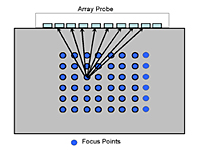TFM
Total Focusing Method
TFM – Total Focusing Method – is a technique of using the data from Full Matrix Capture (FMC – see left) to produce an image which is focused at every specified point in the image. TFM is implemented by applying an algorithm to the full data set collected by FMC.
The first step in applying TFM is to define the grid of focusing points. The data obtained from each transmitter/receiver combination is summed for each particular focusing point in the grid. The image is therefore constructed using the maximum amount of information available for each point.

The image is a colour-coded display of the amplitudes produced after application of the TFM algorithm.
The figure shows the basic principle of TFM.
For more information on TFM and FMC see:
'The post-processing of ultrasonic array data using the total focusing method', by C Holmes, B W Drinkwater and P D Wilcox, Insight, 46(11), 677-680, 2005.
What the hec?! articles are not intended to be the definitive account on the topic or acronym in question. Readers’ comments and contributions are welcomed. Email: ndtnews@bindt.org
The first step in applying TFM is to define the grid of focusing points. The data obtained from each transmitter/receiver combination is summed for each particular focusing point in the grid. The image is therefore constructed using the maximum amount of information available for each point.

The image is a colour-coded display of the amplitudes produced after application of the TFM algorithm.
The figure shows the basic principle of TFM.
For more information on TFM and FMC see:
'The post-processing of ultrasonic array data using the total focusing method', by C Holmes, B W Drinkwater and P D Wilcox, Insight, 46(11), 677-680, 2005.
What the hec?! articles are not intended to be the definitive account on the topic or acronym in question. Readers’ comments and contributions are welcomed. Email: ndtnews@bindt.org